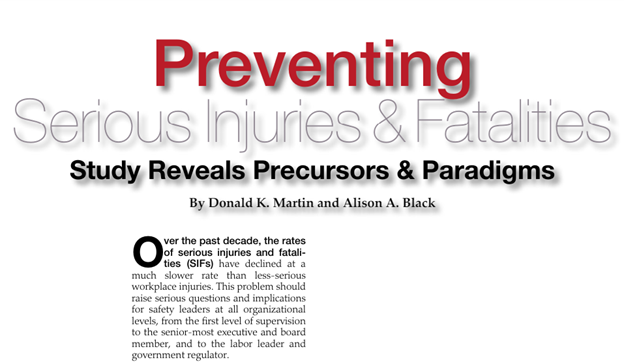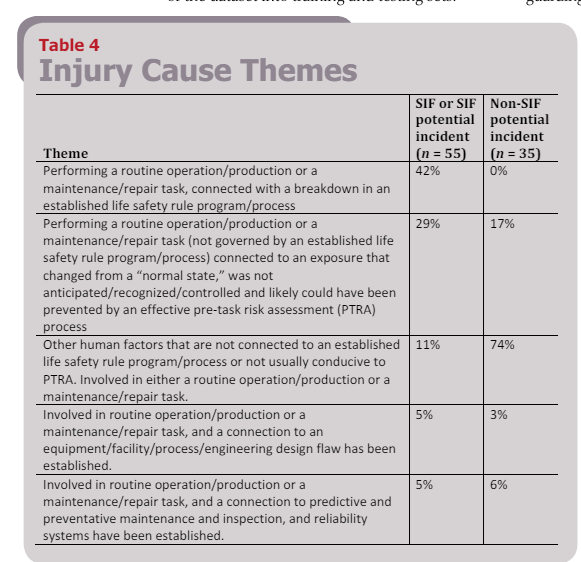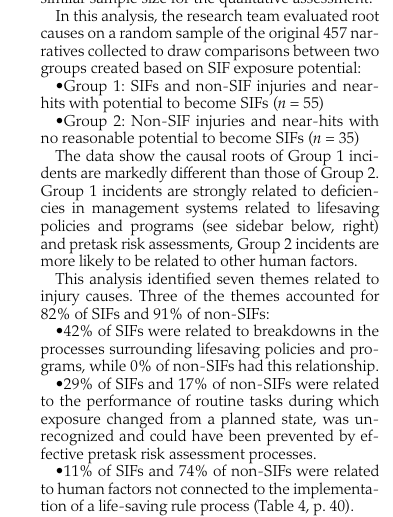
This study explored the precursors and a suggested paradigm shift in the management of SIFs.
They drew on data from seven multinational organisations: monthly injury data (fatal and non-fatal), comprehensive narratives for all serious injuries over the past 2 years and a sample of non-SIFs.
Providing background:
· “Over the past decade, the rates of serious injuries and fatalities (SIFs) have declined at a much slower rate than less-serious workplace injuries”
· US data indicates that while non-fatal recordables have declined steadily over the past two decades (51% in 15 years to 34% in the past 10)
· The fatality rate has also declined, but at a much less dramatic rate: 12.5% in the past 10 years and 25.5% in the past 15 years
Results
The safety triangle is descriptively accurate
First they talk about the safety triangle, confirming the (rather obvious) trend that less-severe injuries occur more frequently than serious injuries.
Results indicated an inverse relationship between frequency and severity and that the “ratio of less to more severe injuries varies among companies, and that no constant ratio exists” [** FYI – my understanding is that Heinrich never claimed this].
A Subset of Reported Incidents Will Have SIF Exposure Potential
They indicate that a pattern emerged after assessing the injuries case-by-case, whereby a percentage of cases originally reported as nonserious contained the potential for something significantly worse to happen (e.g. low actual severity but high potential severity).
The safety triangle is not accurate predictively
Analysis of the data “clearly indicated that not all incidents had the potential to be an SIF. This logically leads to a conclusion that reducing the frequency of less-severe incidents at the bottom of the triangle does not necessarily reduce the number at the top in a proportional way” [** Again, based on Carsten Busch’s work, I’m not sure this is what Heinrich actually said nor intended].
The potential for a SIF is variable across a range of less serious injuries that occur and different types of exposure. Hence, initiatives can be effective at lowering the number of injuries with low SIF potential, but largely ineffective for lowering high SIF potential.
Nonserious injuries with high exposure potential in this dataset ranged from 10 to 36%, and is “organization- and location-specific, and in all cases is a subset of all reported lower severity injuries”.

The Contributing Factors for SIFs Are Different Than Those That Underlie Non-SIFs
Their data indicated that “The causes and roots of SIFs and non-SIFs are measurably different”.
The researchers evaluated the narratives and other data, comparing between two groups created based on SIF exposure potential:
Group 1: SIFs and non-SIF injuries and near-hits with potential to become SIFs (n = 55)
Group 2: Non-SIF injuries and near-hits with no reasonable potential to become SIFs (n = 35)

The ‘causal roots’ of group 1 incidents were markedly different to those in group 2 – group 1 incidents were “strongly related to deficiencies in management systems related to lifesaving policies and programs …and pre-task risk assessments” [** Perplexing finding about pre-task risk assessments…presumably they mean last-minute/dynamic assessments? If so, then that seems late in the piece to be relying on except perhaps as a final check of assumptions.]
Group 2, the non-SIFs with no reasonable potential to become SIFs were more related to people factors.
They say that three themes accounted for 82% of SIFs and 91% of non-SIFs:
· 42% of SIFs related to breakdowns in processes of lifesaving policies and programs, whereas 0% of non-SIFs were related to lifesaving policies
· 29% of SIFs and 17% of non-SIFs were related to routine tasks, during “which exposure changed from a planned state, was unrecognized”; which they conject that this unexpected change could have been identified via a pre-task risk assessment […meh]
· 11% of SIFs and 74% of non-SIFs were related to people factors not connected to life-saving processes
Group 1 incidents were also more strongly connected with two variables: work activities and work situations. E.g. mobile plant, watercraft, working under suspended loads and working at elevation.
They state that “Of 126 injuries sustained in association with these activities, 114 (90.5%) were Group 1, and only 12 injuries were Group 2”. Further, 36 of this sample were associated with poor or risky standard operating procedures, or drift from “normal procedures…over time”.
Group 1 was exclusively associated with particular exposure sources or safety controls, including: equipment and pipe opening of HAZCHEM, lockout/tagout, machine guarding and barricades, confined space entry. They argue that these findings “confirms that data on high-potential non-SIF outcome cases can be useful in defining exposure to SIF”.
They say that SIF precursors were discoverable through observation, inspections, interviews, near-hit reports and injury reports. One technique that they found to be useful for ID SIF precursors is longitudinal analysis – being repeated observations of events/work over long periods of time.
Longitudinal analysis can apparently reveal “SIF precursors [that] have existed in an organization/site for a long time” and that when this short-term blindspot is removed, “it becomes equally obvious that the occurrence of an SIF event should not be viewed as a one-off or fluke event”.
Discussion
First they summarise key findings, being:
· The safety triangle is accurate descriptively but not accurate predictively
· A subset of reported safety incidents will have SIF exposure potential
· The causal factors for SIFs are “different in kind than those that underlie non-SIFs”
· It’s unlikely that a SIF is a one-off, considering that the precursors leading to it have been present all along
The New Paradigm for Prevention of SIFs
Based on these findings, the authors propose a “new paradigm” for understanding SIFs:
1) Don’t expect SIF prevention by working outside of the SIF triangle. That is, “Because the causes of SIF cases are different than non-SIF cases, working in the 79% non-SIF section of the injury triangle is unlikely to prevent SIF cases”
2) Recordable injury logs are “misleading when it comes to SIF exposure”. Organisations should review all reported incidents to identify those with SIF exposure potential [** and all normal and irregular work].
Here they discuss the misleading nature of OSHA logs and recordable injuries, such that two cases could appear identical due to outcome but have wildly different potential SIF exposures. They suggest that “Most organizations do not have consistent visibility of these data because they [are] buried in the category of recordable injuries and because those with high SIF are not distinguished from those with low SIF”
3) The SIF blind spot is significant. Again, many organisations have good visibility over non-SIF potential intel, but not consistent and clear visibility over SIF potentials, nor “consistent visibility needed to address precursors in sustainable ways”.
Recordable incident rate changes are said to be not indicative of changes to SIF potential.
4) An organisation’s view on SIFs must evolve, via several means (which I’ve mostly skipped). One means is to “Provide visibility to SIF exposure”.
They also note that “SIF precursors are discoverable and a key to intervention design”. SIF precursors are “embedded in high-risk/high-exposure tasks”, and 81% of these SIF exposures occur during routine tasks [** This sounds like another way of promoting a relentless focus on normal work.]
5) Incident reporting and investigations “are not as effective as they should be”. Longitudinal analysis is one means to help improve the identification of contributing factors and precursors.
6) Behaviour-Based Safety is “significant and underused”. In any case, BBS or not, they suggest that the SIF precursors, preconditions and exposures in a sample of 55 SIF/SIF-potential cases evaluated by these authors could have been discoverable in 87% of cases via interviews and observations
7) SIF exposure events are not one-off events. Further, they’re not ‘out of the blue’, and that certain kinds of situations trigger, precede or contribute to SIFs; hence, “SIFs do not occur randomly and that they are virtually never isolated events”.

Authors: Martin, D. K., & Black, A. (2015). Preventing serious injuries and fatalities: Study reveals precursors and paradigms. Professional Safety, 60(09), 35-43.
My site with more reviews: https://safety177496371.wordpress.com
LinkedIn post: https://www.linkedin.com/pulse/preventing-serious-injuries-fatalities-study-reveals-ben-hutchinson-mteoc
One thought on “Preventing Serious Injuries & Fatalities: Study Reveals Precursors & Paradigms”